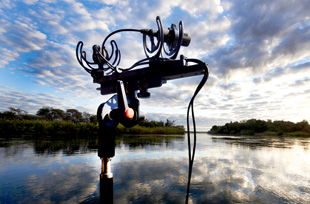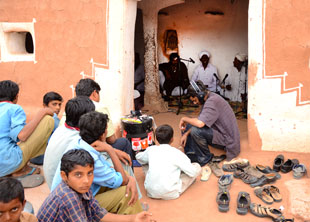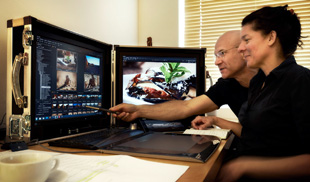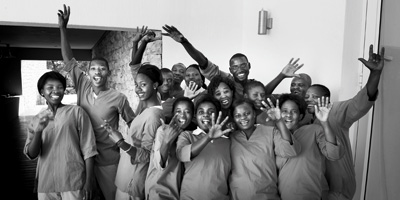![]() Putting a new spin on the early work of Cecil Sharp and ethnomusicologists such as Alan Lomax and David Lewiston who have followed, Sabine Kämper has released Chorus and Cuisine – adding a unique culinary angle to the mission of documenting and preserving endangered music.
Putting a new spin on the early work of Cecil Sharp and ethnomusicologists such as Alan Lomax and David Lewiston who have followed, Sabine Kämper has released Chorus and Cuisine – adding a unique culinary angle to the mission of documenting and preserving endangered music.
But she is not alone in her mission, or in taking on the technical challenges of remote field recording…
Indeed, you could regard Kämper’s brief as the next logical step from the music transcriptions made by Cecil Sharp before it was possible to capture the sound itself. Come to think of it, a recipe’s description of a dish rather recalls the efforts of those first manuscripts to document music.
If so, Lewiston’s recording missions also provided the blueprint for the recording expeditions that followed. His first recordings were made in Bali in 1966 and released as Music from the Morning of the World in 1967.
 Subsequent ventures resulted in extensive recordings of Tibetan Buddhist rituals, the Drukpa Kagyu rituals of Khampagar Gompa and many other cultures around the world.
Subsequent ventures resulted in extensive recordings of Tibetan Buddhist rituals, the Drukpa Kagyu rituals of Khampagar Gompa and many other cultures around the world.
Predating the emergence of ‘ethnic music’ as a commercial genre, he was fortunate that the 1960s and 1970s saw the first lightweight portable recording equipment appear, allowing recordings to be made in remote places. But it wasn’t easy.
‘We’re talking about 1966,’ he said in an interview given to the American Tape Op magazine in 2001. ‘Do you realise that there were no battery-powered stereo portable recorders at that time? The stereo Nagra hadn’t been invented, and the venerable Nagra 3 was still the state-of-the-art field recorder. For stereo, there were Ampex 600s and the like, but nothing that you could take around with you.
‘When I got as far as Singapore, all I had was a mono Uher 4000. It was used by reporters a lot, weighed about eight pounds, and ran on lead-acid batteries. I also had a pair of very decent small condenser mics, which a friend had lent me. Imagine my delight when I walked into a store on Orchard Road in Singapore and saw a battery-operated stereo recorder called the Concertone 727, selling for less than 200 bucks! It took five-inch reels and was pretty flimsy.’
Since then, digital recording and other advances in technology have made recording expeditions more practical. But it still isn’t easy…
‘The only DAT recorder that I feel works, if we’re still talking stereo, is the [HHB] PortaDAT,’ Lewiston told Tape Op. ‘Maybe the Fostex PD2 or PD4 are good, but I’ve never used one. The problem is that young people who want to go off and record just don’t have $15,000 for equipment. You’ve got to have at least three batteries and then you need a selection of mics. I have a pair of [Neumann] KM 84s, a pair of KM 83s, the [Sennheiser] MKH20, and a pair of inexpensive [Electro-Voice] RE50s because I find they’re absolutely well behaved.
‘In fact, in ’87 I used only the RE50s in Bali, and everybody is amazed at the quality of the recordings. Here I am using a pair of inexpensive dynamics and the transients aren’t bothered at all. While this mic has a fairly steep fall-off below 100Hz and above 13kHz, it’s perfect for Bali.’
From its base in Australia, Greg Simmons’ GE-OS (Guerrilla Ethnomusicology – Open Source) project aims to take audio students and other interested parties on international recording expeditions to capture the sounds and music of different countries and cultures. A live diary from one of these forays was posted on Fast-and-Wide in 2011, and documented the use of a selection of DPA mics and an HHB PortaDrive portable hard-disk recorder. Mic placement called on a variety of systems including ORTF stereo.
 Another currently active project is based in India, where Ankur Malhotra and Ashu Sharma run their Amarrass record label and music festival. The label is devoted to preserving their country’s ethnic music through an ongoing series of field recordings – directly inspired by the work of Sharp and Lomax. ‘The world wouldn’t know about a lot of music if it wasn’t for people like them,’ Malhotra told a recent BBC radio programme.
Another currently active project is based in India, where Ankur Malhotra and Ashu Sharma run their Amarrass record label and music festival. The label is devoted to preserving their country’s ethnic music through an ongoing series of field recordings – directly inspired by the work of Sharp and Lomax. ‘The world wouldn’t know about a lot of music if it wasn’t for people like them,’ Malhotra told a recent BBC radio programme.
‘We’ve been at it for about two-and-a-half years now and we’ve barely scratched the surface,’ he says. ‘But time is not on our side, or on the side of the musicians. There is a sense of urgency to go out and capture these masters of music, this oral tradition, before it gets lost forever.
‘The first time we went, we had a cassette recorder and some high-quality mics, and we went to people’s homes. But sometimes there might be a flour mill in operation in the background, and to do justice to the recording we would have to scout for another place where there were no external noises and no wind noise. That’s the thing with recording in the field – you never know what you are going to get.’
The audio equipment used has evolved over the past two years, beginning with two-channel analogue tape: ‘Our first recordings [December 2010, April 2011] were made on a Sony TC5 Pro 2 cassette deck, chrome cassette tapes and two Sennheiser e835 microphones,’ Malhotra says. ‘These were featured on our first series of field recordings – Mitha Bol and Banko Ghodo. Mitha Bol was nominated for Folk Album of the Year for the 2012 Global Indian Music Academy (GIMA) Awards.
‘While we have continued recording with the analogue set-up, we have also embraced digital recorders and mixers. Our most recent batch of releases – three CDs recorded in May 2012 and released in November as the At Home series with Lakha Khan, Sakar Khan and Barmer Boys – were recorded digitally using a Sound Devices 552 Field Mixer, a combination of Sterling and AKG condensor mics for strings and percussion, Sennheiser e602 for percussion and Sennheiser e935 mics for vocals. For interconnects and cabling, we used a combination of Zu Audio and LiveWire XLR interconnects.’
Kämper on course
The result of a 9,000km trip from the Kalahari to Kaokoveld, Chorus and Cuisine – Namibia is a unique mix of travel guide, recipe book and music CD. The background to Kämper’s project saw the journalist and author from Hamburg travel through Namibia, collecting local recipes, and recording ethnic choirs and the sounds of nature. ‘That perhaps sounds a little unusual at first,’ she says, ‘but not when I tell you the story that led up to it...
‘In 2008, I was at The Fort lodge in the Onguma Game Reserve in the Etosha National Park,’ she begins. ‘After an excellent dinner, many of the female guests begged the chef to reveal the recipe for his soup. He did so, and everyone was happy.
 ‘I’m a passionate collector of recipes when I’m travelling and I also like to buy CDs of the typical music of the country as a holiday souvenir. In Southern Africa, it is customary on many of the lodges and guest farms for the kitchen staff or even the entire team to perform a few traditional songs after the meal – and that was what they did in Onguma. That was the birth of Chorus and Cuisine.’
‘I’m a passionate collector of recipes when I’m travelling and I also like to buy CDs of the typical music of the country as a holiday souvenir. In Southern Africa, it is customary on many of the lodges and guest farms for the kitchen staff or even the entire team to perform a few traditional songs after the meal – and that was what they did in Onguma. That was the birth of Chorus and Cuisine.’
Kämper’s publishing company, kuduhear, follows the African tradition of narrative and oral culture through audiobooks documenting stories from and about Africa. These use location sound recordings, interviews and music that she journeys to collect.
After lengthy preparations, 2012 saw Kämper and her partner, Detlef Overmann, heading to Namibia for a tour of 18 lodges, where they would record the staff choirs, collect recipes and photograph the dishes.
‘It was clear to me I would have to do a lot of improvising when it came to the audio recordings,’ she recalls. ‘We could expect to be recording in different kinds of rooms, from libraries to laundries. For that reason, we needed microphones that guaranteed good recordings whatever the situation, and so I turned to Sennheiser’s experts for help.’
Sennheiser recommended the MKH 8040, a condenser mic with a cardioid pickup pattern – in part because of the high temperatures expected on her tour, and as Kämper was also planning to make outdoor recordings for another project.
‘In the end, we never actually needed to record in a laundry,’ she says. ‘Most of the time, we somehow managed to squeeze the choir into our lodge room or we were able to record in the kitchen. Once, the lodge manager even let us use his living room.’
The recordings were to be made to a laptop computer running Pro Tools 8 via a Digidesign Mbox2 interface, with a little help from a prototype windshield from Rycote. ‘The mic set-up was always an ORTF arrangement fed via the Mbox2,’ Kämper confirms. ‘Additionally, I placed a Sony PCM-D50 mobile recorder on the same centre line (with some distance). For the choirs with not so many members we used these additional recordings on a third and fourth track to give them a little more volume. This lightweight and compact audio system provided us with excellent recordings.
‘After the rough cut, I asked the audio engineer what he had done to the recordings to make them sound so perfectly “rounded”, and he said, “not much – I only put the songs in the order you wanted…”.’
African soundscapes
 Kämper and Overmann also used their journey through Namibia to make recordings for a second project – Soundscapes. This involved recording characteristic sounds of the countryside, which they would then offer to Namibian artists to use as a basis and background for music compositions.
Kämper and Overmann also used their journey through Namibia to make recordings for a second project – Soundscapes. This involved recording characteristic sounds of the countryside, which they would then offer to Namibian artists to use as a basis and background for music compositions.
‘For the atmospheric sounds, for example, I thought of the barking gecko in the desert, the dawn chorus of birds and the sound of antelopes at a waterhole,’ Kämper says. ‘I wanted to record village sounds or simply the rushing of the Atlantic waves.’
A major challenge to this was wind noise, as it is often stormy in the desert in the evening. The author also worried about the microphones being constantly exposed to fine sand and dust.
‘The Rycote windshield prototype was just what I needed, and the equipment turned out to be extremely sturdy,’ she reports. ‘I was able to record really wonderful natural background sounds, and the production with the artists is scheduled to begin in 2013.
‘The microphones were simply fantastic too. On the first recordings in the bush in the Kalahari, I noticed a kind of buzzing and whizzing sound that I couldn’t explain. The interface was OK, the headphones were fine, the microphones were working perfectly, and there was nothing wrong with my ears. In the end, I found out that I had recorded the wing beats of some weaver birds on a tree some distance away!’
Kämper’s mission may lack some of the academic integrity enjoyed by David Lewiston and those earlier pioneers, but its cross-sensory approach has given Greg Simmons pause for thought: ‘What a wonderful combination... food and music,’ he smiles. ‘Why didn't I think of doing that?’
Why indeed? Maybe we will even see taste join sound, colour and 3D in the next chapter of documentary programme making. Food for thought, maybe…

